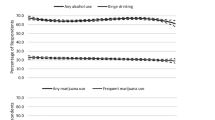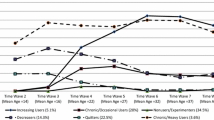Abstract
Previous studies have identified an association between depressive mood and marijuana use. We examined adolescent self-control as a predictor of membership in joint developmental trajectories of depressive mood and marijuana use from adolescence to young adulthood. Urban African Americans and Puerto Ricans (N = 838) were sampled when participants were on average 14, 19, 24, and 29 years old. Using growth mixture modeling, four joint trajectory groups of depressive mood and marijuana use were established: low marijuana use/low depressive mood, low marijuana use/intermediate depressive mood, high marijuana use/low depressive mood, and high marijuana use/high depressive mood. Weighted logistic regression analysis showed that self-control at age 14 distinguished the high marijuana use/high depressive mood group and the low marijuana use/low depressive mood group from each of the other groups. Findings show that the co-occurrence of high levels of marijuana use and depressive mood from adolescence into young adulthood is predicted by low levels of self-control in adolescence. On the other hand, high selfcontrol is associated with low marijuana use and low levels of depression over time. Thus, while deficits in self-control in adolescence constitute a significant risk for maladjustment over time, high self-control exerts a protective factor with regard to marijuana use and depressive mood into young adulthood.

Similar content being viewed by others
Notes
A longer version of the depression scale was available only at T3 and T4. The correlations between the 2-item scale and the longer version were r = 0.76 (p < 0.0001) and r = 0.81 (p < 0.0001) at T3 and T4 respectively.
References
Arneklev, B. J., Grasmick, H. G., & Bursik, R. J, Jr. (1999). Evaluating the dimensionality and invariance of “low self-control”. Journal of Quantitative Criminology, 15, 307–331.
Block, J. H., Gjerde, P. F., & Block, J. H. (1991). Personality antecedents of depressive tendencies in 18-year-olds: A prospective study. Journal of Personality and Social Psychology, 60, 726–738.
Brook, J. S., Brook, D. W., Gordon, A. S., Whiteman, M., & Cohen, P. (1990). The psychosocial etiology of adolescent drug use: A family interactional approach. Genetic, Social, and General Psychology Monographs, 116, 113–267.
Brook, J. S., Pahl, K., & Ning, Y. (2006). Peer and parental influences on longitudinal trajectories of smoking among African Americans and Puerto Ricans. Nicotine & Tobacco Research, 8, 639–651.
Buchan, B. J., Dennis, M. L., Tims, F. M., & Diamond, G. S. (2002). Cannabis use: consistency and validity of self-report, on-site urine testing and laboratory testing. Addiction, 97, 98–108.
Carver, C. S., & Scheier, M. F. (2011). Self-regulation of action and affect. In K. D. Vohs & R. F. Baumeister (Eds.), Handbook of self-regulation: Research, theory, and applications (2nd ed., pp. 3–21). New York, NY: Guilford Press.
Chen, C. Y., Wagner, F. A., & Anthony, J. C. (2002). Marijuana use and the risk of major depressive episode: Epidemiological evidence from the United States National Comorbidity Survey. Social Psychiatry and Psychiatric Epidemiology, 37, 199–206.
Davey, C. G., Yücel, M., & Allen, N. B. (2008). The emergence of depression in adolescence: Development of the prefrontal cortex and the representation of reward. Neuroscience and Biobehavioral Reviews, 32, 1–19.
Degenhardt, L., Hall, W., & Lynskey, M. (2001). Alcohol, cannabis, and tobacco use among Australians: A comparison of their associations with other drug use and use disorders, affective and anxiety disorders, and psychosis. Addiction, 96, 1603–1614.
Degenhardt, L., Hall, W., & Lynskey, M. (2003). Exploring the association between cannabis use and depression. Addiction, 98, 1493–1504.
Derogatis, L. R. (1997). The SCL-90 scoring manual. Baltimore, MD: John Hopkins School of Medicine, Clinical Psychometrics Unit.
Diamond, A., & Lee, K. (2011). Interventions shown to aid executive function development in children 4–12 years old. Science, 333, 959–964.
Feng, X., Keenan, K., Hopwell, A. E., Henneberger, A. K., Rischall, M. S., Butch, J., et al. (2009). Longitudinal associations between emotion regulation and depression in preadolescent girls: Moderation by the caregiving environment. Developmental Psychology, 45, 798–808.
Fergusson, D. M., & Boden, J. M. (2008). Cannabis use and later life outcomes. Addiction, 103, 969–976.
Flook, L., Smalley, S. L., Kitil, M. J., Galla, B. M., Kaiser-Greenland, S., Locke, J., et al. (2010). Effects of mindful awareness practices on executive functions in elementary school children. Journal of Applied School Psychology, 26, 70–95.
Friedman, A. S., Terras, A., Zhu, W., & McCallum, J. (2004). Depression, negative self-image, and suicide attempts as effects of substance use and substance dependence. Journal of Addictive Diseases, 23, 55–71.
Gottfredson, M. R., & Hirschi, T. (1990). A general theory of crime. Stanford, CA: Stanford University Press.
Gramzow, R. H., Sedikides, C., Panter, A. T., & Insko, C. A. (2000). Aspects of self-regulation and self-structure as predictors of perceived emotional distress. Personality and Social Psychology Bulletin, 110, 86–108.
Grasmick, H. G., Tittle, C. R., Bursick, R. J, Jr, & Arneklev, B. J. (1993). Testing the core empirical implications of Gottfredson and Hirschi’s general theory of crime”. Journal of Research in Crime and Delinquency, 30, 5–29.
Jessor, R., Graves, T. D., Hanson, R. C., & Jessor, S. L. (1968). Society, personality, and deviant behavior: A study of a tri-ethnic community. New York: Holt, Rinehart, & Winston.
Lakes, K. D., & Hoyt, W. T. (2004). Promoting self-regulation through school- based martial arts training. Applied Developmental Psychology, 25, 283–302.
Libby, A. M., Orton, H. D., Stover, S. K., & Riggs, P. D. (2005). What came first, major depression or substance use disorder? Clinical characteristics and substance use comparing teens in a treatment cohort. Addictive Behaviors, 30, 1649–1662.
Lochman, J. E., & Pardini, D. A. (2008). Cognitive-behavioral therapies. In M. Rutter, D. V. M. Bishop, D. S. Pine, S. Scott, J. Stevenson, E. Taylor, & A. Thapar (Eds.), Rutter’s child & adolescent psychiatry (5th ed., pp. 1026–1045). Malden, Massachusetts: Blackwell Publishing Limited.
Magar, E. C. E., Phillips, L. H., & Hosie, J. A. (2008). Self regulation and risk taking. Personality and Individual Differences, 45, 153–159.
Malouf, E., Stuewig, J., & Tangney, J. (2012). Self-control and jail inmates’ substance misuse post-release: Mediation by friends’ substance use and moderation by age. Addictive Behaviors, 37, 1198–1204.
Marmorstein, N. R., Iacono, W. G., & Malone, S. M. (2010). Longitudinal associations between depression and substance dependence from adolescence through early adulthood. Drug and Alcohol Dependence, 107, 154–160.
Muraven, M., & Baumeister, R. F. (2000). Self-regulation and depletion of limited resources: Does self-control resemble a muscle? Psychological Bulletin, 126, 247–259.
Muthén, L.K., & Muthén, B.O. (2010). Mplus user’s guide (6th ed.). Los Angeles, CA: Muthén & Muthén; 2010. Retrieved from http://www.statmodel.com/download/usersguide/Mplus%20Users%20Guide%20v6.pdf.
Nagin, D. S. (2005). Group-based modeling of development. Cambridge, MA: Harvard University Press.
Olson, S. L., & Lunkenheimer, E. S. (2009). Expanding concepts of self-regulation to social relationships: Transactional processes in the development of early behavioral adjustment. In A. Sameroff (Ed.), The transactional model of development: How children and contexts shape each other (pp. 55–76). Washington, DC: American Psychological Association.
Otten, R., Barker, E. D., Maughan, B., Arseneault, L., & Engels, R. C. M. E. (2010). Self-control and its relation to joint developmental trajectories of cannabis use and depressive mood symptoms. Drug and Alcohol Dependence, 1(12), 201–208.
Pahl, K., Brook, J. S., & Koppel, J. (2010). Trajectories of marijuana use and psychological adjustment among urban African American and Puerto Rican women. Psychological Medicine, 41, 1775–1783.
Pahl, K., Brook J. S., & Lee, J. Y. (2012). Joint trajectories of victimization and marijuana use and their health consequences among urban African American and Puerto Rican young men. Journal of Behavioral Medicine. Advance Online Publication.
Patton, G. C., Coffey, C., Carlin, J. B., Degendardt, L., Lynskey, M., & Hall, W. (2002). Cannabis use and mental health in young people: A cohort study. British Medical Journal, 325, 1199–1212.
Piquero, A. R., Jennings, W. G., & Farrington, D. P. (2010). Self-control interventions for children under age 10 for improving self-control and delinquency and problem behaviors. Campbell Systematic Review, 2, 1–117.
Pulkkinen, L., Lyyra, A. L., & Kokko, K. (2011). Is social capital a mediator between self-control and psychological and social functioning across 34 years? International Journal of Behavioral Development, 35, 475–481.
Smith, G. M., & Fogg, C. P. (1979). Psychological antecedents of teenage drug use. In R. Simmons (Ed.), Research in community and mental health: An annual compilation of research, Vol. 1 (pp. 87–102). Greenwich, CT: JAI Press.
Steinberg, L. (2005). Cognitive and affective development in adolescence. Trends in Cognitive Sciences, 9, 69–74.
Sussman, S., McCuller, W. J., & Dent, C. W. (2003). The associations of social self-control, personality disorders, and demographics with drug use among high-risk youth. Addictive Behaviors, 28, 1159–1166.
Tangney, J. P., Baumeister, R. F., & Boone, A. L. (2004). High self-control predicts good adjustment, less pathology, better grades, and interpersonal success. Journal of Personality, 72, 271–324.
Turner, M. G., & Piquero, A. R. (2002). The stability of self-control. Journal of Criminal Justice, 30, 457–471.
Way, N., Stauber, H. Y., Nakkula, M. J., & London, P. (1994). Depression and substance use in two divergent high school cultures: A quantitative and qualitative analysis. Journal of Youth and Adolescence, 23, 331–357.
Whitmore, E. A., Mikulich, S. K., Thompson, L. L., Riggs, P. D., Aarons, G. A., & Crowley, T. J. (1997). Influences on adolescent substance dependence: Conduct disorder, depression, attention deficit hyperactivity disorder, and gender. Drug and Alcohol Dependence, 47, 87–97.
Wills, T. A., Ainette, M. G., Stoolmiller, M., Gibbons, F. X., & Shinar, O. (2008). Good self-control as a buffering agent for adolescent substance use: An investigation in early adolescence with time-varying covariates. Psychology of Addictive Behaviors, 22, 459–471.
Wyman, P. A., Cross, W., Brown, C. H., Yu, Q., Tu, X., & Eberly, S. (2010). Intervention to strengthen emotional self-regulation in children with emerging mental health problems: Proximal impact on school behavior. Journal of Abnormal Child Psychology, 38, 707–720.
Zaldívar, B. F., García, M. J. M., Flores, C. P., Sánchez, S. F., López, R. F., & Molina, M. A. (2009). Validity of the self-report on drug use by university students: Correspondence between self-reported use and use detected in urine. Psicothema, 21, 213–222.
Acknowledgments
The authors wish to thank Elizabeth Rubenstone for her comments and Nataliya K. Byrne and Jordyn Cohen for their assistance with the preparation of this manuscript. This research was supported by Grants from the National Institutes of Health (NIH): DA000244 awarded to Judith S. Brook, and DA005702 awarded to Judith S. Brook and Kerstin Pahl.
Conflict of interest
None.
Author information
Authors and Affiliations
Corresponding author
Rights and permissions
About this article
Cite this article
Pahl, K., Brook, J.S. & Lee, J.Y. Adolescent self-control predicts joint trajectories of marijuana use and depressive mood into young adulthood among urban African Americans and Puerto Ricans. J Behav Med 37, 675–682 (2014). https://doi.org/10.1007/s10865-013-9518-5
Received:
Accepted:
Published:
Issue Date:
DOI: https://doi.org/10.1007/s10865-013-9518-5




